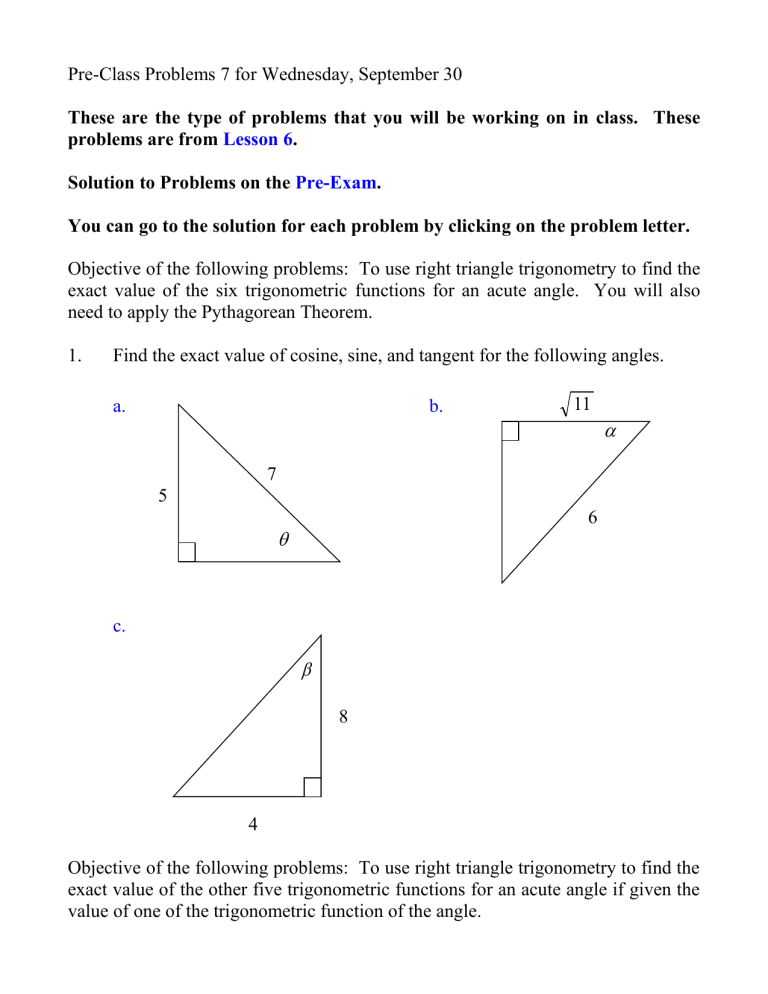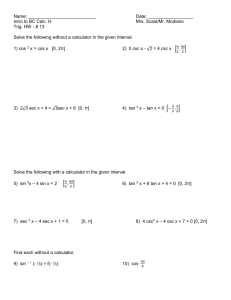Pre-Class Problems 7

Pre-Class Problems 7 for Wednesday, September 30
These are the type of problems that you will be working on in class. These problems are from Lesson 6 .
Solution to Problems on the Pre-Exam .
You can go to the solution for each problem by clicking on the problem letter.
Objective of the following problems: To use right triangle trigonometry to find the exact value of the six trigonometric functions for an acute angle. You will also need to apply the Pythagorean Theorem.
1. Find the exact value of cosine, sine, and tangent for the following angles.
5
7
11
6
4
8
Objective of the following problems: To use right triangle trigonometry to find the exact value of the other five trigonometric functions for an acute angle if given the value of one of the trigonometric function of the angle.
2. Use a right triangle to find the exact value of the other five trigonometric functions of the angle if given the following information.
cos
4
7
and
is an acute angle
tan
3
and
is an acute angle
5
csc
8
3
and
is an acute angle
Objective of the following problems: To determine what quadrant the terminal side of an angle is in if given the sign of two trigonometric functions of the angle.
3. Determine what quadrant the following angles are in if given the following information.
cos
0 and sin
0
sin
0 and sec
0
cos
0 and csc
0
sin
0 and tan
0
cos
0 and cot
0
tan
0 and sec
0
cot
0 and csc
0
csc
0 and sec
0
Additional problems available in the textbook: Page 146 … 5 - 20. Page 140 …
Example 1. Page 156 … 19 - 22.
Solutions:
1a.
5 7
24
NOTE: You use the Pythagorean Theorem to find the value of 24 . cos
adj hyp
24
, sin
7
opp hyp
5
,
7 tan
opp adj
Answer: cos
24
, sin
7
5
7
, tan
5
24
1b.
5
11
6
NOTE: You use the Pythagorean Theorem to find the value of 5.
5
24
cos
adj hyp
11
, sin
6
opp hyp
5
6
, tan
opp adj
5
11
Answer: cos
11
, sin
6
5
6
, tan
5
11
1c.
80
4 5
4
8
NOTE: You use the Pythagorean Theorem to find the value of cos
adj hyp
4
8
5
tan
opp adj
4
8
1
2
2
5
, sin
opp hyp
4
4
5
1
5
,
80 .
Answer: cos
2
5
, sin
1
5
, tan
1
2
2a. cos
4
7
and
is an acute angle cos
4
7
sec
7
4
NOTE: We do not need to use right triangle trigonometry to find this value.
NOTE: cos
4
7
adj hyp
7
33
4
NOTE: You use the Pythagorean Theorem to find the value of 33 . sin
opp hyp
33
7 csc
hyp opp
7
33 tan
opp adj
Answer: sin
33
4
33
7
, tan
cot
adj opp
33
, sec
4
4
33
7
4
, csc
cot
4
33
7
33
,
2b. tan
5
3
and
is an acute angle tan
5
3
cot
5
3
NOTE: We do not need to use right triangle trigonometry to find this value.
NOTE: tan
5
3
opp adj
28
3
5
NOTE: You use the Pythagorean Theorem to find the value of 28 . cos
adj hyp
5
28 sec
hyp adj
28
5 sin
opp hyp
3
28 csc
hyp opp
28
3
Answer: cos
5
28
, sin
3
28
, sec
28
,
5 csc
28
, cot
3
5
3
2c. csc
8
3
and
is an acute angle csc
8
3
sin
3
8
NOTE: We do not need to use right triangle trigonometry to find this value.
NOTE: sin
3
8
opp hyp
8
3
55
NOTE: You use the Pythagorean Theorem to find the value of 55 . cos
adj hyp
55
8 sec
hyp adj
8
55 tan
opp adj
3
55 cot
adj opp
55
3
Answer: cos
55
, sin
8
3
,
8 tan
3
55
,
sec
8
55
, cot
55
3
3a.
cos
0 and sin
0
Using Method 1, which is Unit Circle Trigonometry, from Lesson 6 :
Recall Unit Circle Trigonometry: P (
)
( cos
, sin
) cos
0
x
0 sin
0
y
0
Answer: IV
NOTE: The quadrant where x -coordinates are positive and y -coordinates are negative is the fourth quadrant.
Using Method 2 from Lesson 6 : cos
0 sin
0 y y
X x
X X X
x
Answer: IV
3b.
sin
0 and sec
0
Using Method 1, which is Unit Circle Trigonometry, from Lesson 6 :
Recall Unit Circle Trigonometry: P (
)
( cos
, sin
) sin
0
y
0 sec
0
cos
0
x
0
Answer: II
NOTE: The quadrant where x -coordinates are negative and y -coordinates are positive is the second quadrant.
NOTE: Cosine and secant are reciprocals of each other. The sign of reciprocals is the same.
Using Method 2 from Lesson 6 : sin
0 sec
0 or cos
0 y y
X X X x
X
x
Answer: II
3c. cos
0 and csc
0
Using Method 1, which is Unit Circle Trigonometry, from Lesson 6 :
Recall Unit Circle Trigonometry: P (
)
( cos
, sin
) cos
0
x
0 csc
0
sin
0
y
0
Answer: III
NOTE: The quadrant where x -coordinates are negative and y -coordinates are negative is the third quadrant.
NOTE: Sine and cosecant are reciprocals of each other. The sign of reciprocals is the same.
Using Method 2 from Lesson 6 : cos
0 csc
0 or sin
0 y y
X x
X X X
Answer: III
x
3d. sin
0 and tan
0
Using Method 1, which is Unit Circle Trigonometry, from Lesson 6 :
Recall Unit Circle Trigonometry: P (
)
( cos
, sin
) sin
0
y
0 tan
0 :
(
)
tan
y
(
)
x
0 x ?
Answer: IV
NOTE: The quadrant where x -coordinates are positive and y -coordinates are negative is the fourth quadrant.
NOTE: A negative divided by a positive will produce a negative result.
Division with unlike signs will produce a negative.
Using Method 2 from Lesson 6 : sin
0 tan
0 y y
X x
X X X
Answer: IV
x
3e. cos
0 and cot
0
Using Method 1, which is Unit Circle Trigonometry, from Lesson 6 :
Recall Unit Circle Trigonometry: P (
)
( cos
, sin
) cos
0
x
0 cot
0
tan
0 :
(
)
tan
y x
?
(
)
y
0
Answer: III
NOTE: The quadrant where x -coordinates are negative and y -coordinates are negative is the third quadrant.
NOTE: Tangent and cotangent are reciprocals of each other. The sign of reciprocals is the same.
NOTE: A negative divided by a negative will produce a positive result.
Division with like signs will produce a positive.
Using Method 2 from Lesson 6 : cos
0 cot
0 or tan
0 y y
X x
X
Answer: III
X
X
x
3f. tan
0 and sec
0
Using Method 1, which is Unit Circle Trigonometry, from Lesson 6 :
Recall Unit Circle Trigonometry: P (
)
( cos
, sin
) sec
0
cos
0
x
0 tan
0 :
(
)
tan
y x
?
(
)
y
0
Answer: II
NOTE: The quadrant where x -coordinates are negative and y -coordinates are positive is the second quadrant.
NOTE: Cosine and secant are reciprocals of each other. The sign of reciprocals is the same.
NOTE: A positive divided by a negative will produce a negative result.
Division with unlike signs will produce a negative.
Using Method 2 from Lesson 6 : tan
0 sec
0 or cos
0 y y
X X x
X X
Answer: II
x
3g. cot
0 and csc
0
Using Method 1, which is Unit Circle Trigonometry, from Lesson 6 :
Recall Unit Circle Trigonometry: P (
)
( cos
, sin
) csc
0
sin
0
y
0 cot
0
tan
0 :
(
)
tan
y
(
)
x
0 x ?
Answer: II
NOTE: The quadrant where x -coordinates are negative and y -coordinates are positive is the second quadrant.
NOTE: Sine and cosecant are reciprocals of each other. The sign of reciprocals is the same.
NOTE: Tangent and cotangent are reciprocals of each other. The sign of reciprocals is the same.
NOTE: A positive divided by a negative will produce a negative result.
Division with unlike signs will produce a negative.
Using Method 2 from Lesson 6 : cot
0 or tan
0 csc
0 or sin
0 y y
X X X x x
X
Answer: II
3h.
csc
0 and sec
0
Using Method 1, which is Unit Circle Trigonometry, from Lesson 6 :
Recall Unit Circle Trigonometry: P (
)
( cos
, sin
) csc
0
sin
0
y
0 sec
0
cos
0
x
0
Answer: IV
NOTE: The quadrant where x -coordinates are positive and y -coordinates are negative is the fourth quadrant.
NOTE: Sine and cosecant are reciprocals of each other. The sign of reciprocals is the same.
NOTE: Cosine and secant are reciprocals of each other. The sign of reciprocals is the same.
Using Method 2 from Lesson 6 : csc
0 or sin
0 sec
0 or cos
0 y y
X x
X X X
Answer: IV
x
Solution to Problems on the Pre-Exam :
11. Given: 7
Find the exact value of a. cos
3
4
3 4
b. csc
4
7
8. If tan
0 and sec
0 , then
lies in which quadrant?
Using Method 1, which is Unit Circle Trigonometry, from Lesson 6 :
Recall Unit Circle Trigonometry: P (
)
( cos
, sin
) sec
0
cos
0
x
0 tan
0 :
(
)
tan
y x
?
(
)
y
0
Answer: II
NOTE: The quadrant where x -coordinates are negative and y -coordinates are positive is the second quadrant.
NOTE: Cosine and secant are reciprocals of each other. The sign of reciprocals is the same.
NOTE: A positive divided by a negative will produce a negative result.
Division with unlike signs will produce a negative.
Using Method 2 from Lesson 6 : tan
0 y
X X x sec
0 or
y cos
X X
x
0
Answer: II






